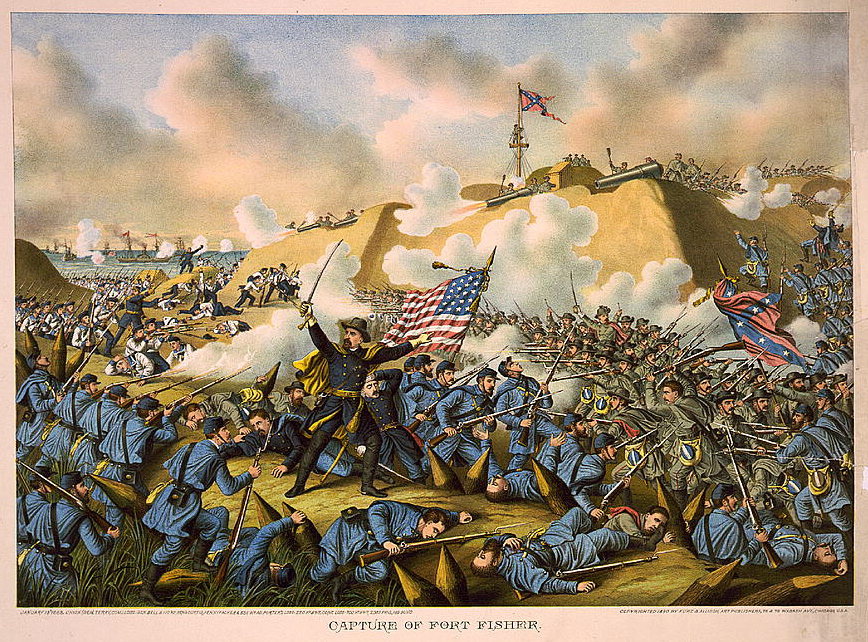The Confederacy died in 1865. The major battles of that year were all Union victories and mercifully shortened the war. Louis Kurz shows three of the significant actions which spelled out the death knell of the Confederacy. He also produced a fourth lithograph that to my knowledge has been absent from illustrated histories, likely because it was printed without color and does not encapsulate a battle.
Capture of Fort Fisher

By 1865, the only Confederate port able to receive blockade runners and keep the Confederate forces, especially Lee's Army of Northern Virginia, alive was at Wilmington, North Carolina. The Union had held off on closing this port because the formidable Fort Fisher stood in the way. In early 1865 they finally made a move on it. The Navy under Admiral David Dixon Porter and a Corps of infantry under General Alfred Terry coordinated a controversially unchallenged landing on January 13 and an assault on January 15. Not properly supported by Confederate units miles away, the Confederate garrison under General George Whiting put up a stout defense, but eventually felt compelled to surrender. This cut the last major lifeline to Trans-Atlantic trade.
The Second Battle of Fort Fisher is an ideal subject for a dramatic lithograph. The Confederates hold the fort against bombardment from the sea and rows of blue-clad infantry and white-shirted sailors. The presence of sailors is not an invention. The naval wing of the Union force was keen on gaining glory and launched a marine assault. This action was separate from the infantry's (against the northeast corner) and ended in failure. The presence of Confederates outside the fort has some historical basis as at one point Whiting ordered a counterattack. The lithograph is centered around a general (perhaps Terry?) and a Union flag.
Battle of Five Forks

This battle is usually chosen as the last in Great Battles of the Civil War books. After failing to take Petersburg outright in June of 1864, General Grant settled his Union forces into a siege. It was not a proper siege, but the armies remained mostly static outside of smaller battles around the flanks. This started to change, with the Battle of Five Forks on April 1 breaking the deadlock for good. General Phil Sheridan's cavalry and General Gouvernor K. Warren's V Corps struck the Confederates at the Five Forks road junction. Sheridan held the enemy in place while Warren's men rolled up their left. Thanks to an acoustic shadow, the Confederate commanders in the area, George Pickett and Fitzhugh Lee, did not know what was happening until it was too late. The resulting Union victory made Robert E. Lee's position at Petersburg untenable.
Kurz chooses the portion of the battle that involved Sheridan's cavalry. In a rarity the massed cavalry charge against infantry is not ahistorical. General George Armstrong Custer did indeed lead a large charge. The Confederates were dispirited enough that it actually worked. The Confederate forces here are surprisingly colorful with blue kepi hats and red-trimmed artillerists. Kurz represents the major consequences of battle with fleeing cannons and supply wagons in the right background. One neat touch is a Confederate artillery officer preparing to butt a dismounted cavalryman with his pistol.
Fall of Petersburg

Alongside Five Forks, several battles in early 1865 seriously stretched Confederate lines around Petersburg. On April 2 the Union Army launched a major attack on Petersburg (the Third Battle of Petersburg as depicted here). Heavily outnumbered Confederates fought to buy time for the evacuation of the Confederate capital of Richmond. Since Grant wanted to strike as fast as possible, the attack began at night well before dawn. The Federals broke through at several points in a smashing victory. Among the Confederates killed was General Ambrose Powell Hill, a famed subordinate of Lee's.
As usual Kurz turns earthworks into fort-like walls. The resulting visual is actually odd when you think about it, with the Federals traversing a series of walls. A wooden stockade rings the fort in the foreground. The momentum is definitely on the Union side, with an officer mounting the fort with the national flag. Kurz also adds some blood to a Confederate in the middle foreground to underscore his side's defeat. While the battle began dead in the night, parts of it did go on until the early afternoon, so the bright sky is not inaccurate.
Capitulation & Surrender of Robt. E. Lee & His Army at Appomattox. VA. to Lt. Genl. U.S. Grant
Grant pursued Lee's army until he finally trapped it near Appomattox Court House. Finally conceding that all was lost, Lee met Grant at the McLean House to discuss surrender terms. Grant, following directives from President Lincoln, was very generous in his terms, allowing officers and enlisted men alike to keep their horses and also to go home. Since Lee was the military figurehead of the South, this was effectively the surrender of the Confederacy though it would hold on for another month. It was also a major step towards reconciliation thanks to the respect shown towards the defeated.
Louis Kurz is one of several illustrators to have the surrender outside instead of McLean's house. He also inaccurately shows Lee offering his sword in surrender. Adding on to the ahistorical elements are the bunches of soldiers behind their respective commanders. Only Lee and an aide were present for the event, and the affair was actually subdued. Appomattox Court House can be seen in the right background. This lithograph was not released in color and is rarely seen in illustrated histories (in fact I never saw it outside the internet).
That wraps it up for Louiz Kurz's Civil War lithographs in this series (though there are several others showing generals and Lincoln). Next we look at some earlier American battles.
No comments:
Post a Comment